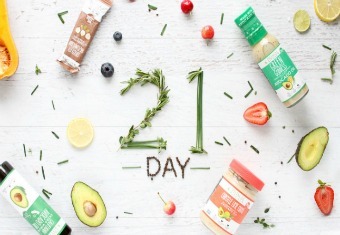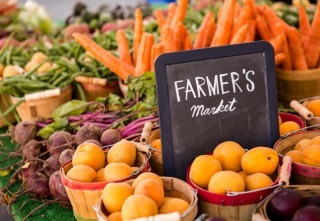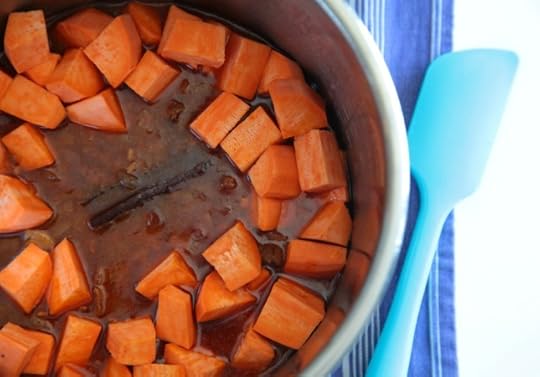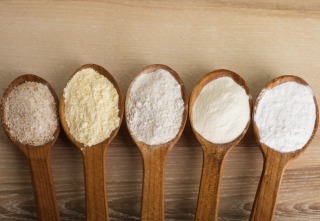Mark Sisson's Blog, page 181
June 1, 2017
7 Alternative Therapies for Depression
 As I discussed last month, depression is the yin to anxiety’s yang. Between these two troublemakers, they’ve got dark clouds hanging over both the past and the future, making the present moment complicated at best (and for some people unbearable). Taken as a human composite, it’s an unfortunate trade-off for being cognitively complex. As individuals, however, we naturally just want a solution.
As I discussed last month, depression is the yin to anxiety’s yang. Between these two troublemakers, they’ve got dark clouds hanging over both the past and the future, making the present moment complicated at best (and for some people unbearable). Taken as a human composite, it’s an unfortunate trade-off for being cognitively complex. As individuals, however, we naturally just want a solution.
The problem is, there’s just so many confounding factors surrounding depression that it’s hard to know where to start. Your mind is an infinitely complex latticework of moving parts; one which continues to baffle and divide the scientific community. How does a practitioner prescribe suitable treatments for a problem they don’t fully comprehend? And, yet, medical science often (and perhaps inevitably) works with incomplete information.
The result is a suite of antidepressant drugs that may be effective in treating certain aspects of depression in certain people, but which also present a suite of their own often-debilitating problems. It doesn’t mean these approaches don’t have their value. I recognize that for some, these medications may be live saving or sustaining. For others, they offer support through acute or overwhelming times or, in still other cases, give a leg up while other interventions have the chance to take hold. My purpose here isn’t to suggest people give these drugs and other conventional treatments the boot. I see this post as a dialogue that offers supplementary strategies to augment any assigned treatment.It can hopefully be or contribute to a toolbox that moves beyond the scope of simple self-care into research-supported territory. And while they’re likely more effective for mild to moderate depression, I think it’s fair to say that no one should write off the therapeutic benefits of healthy lifestyle measures for their overall treatment program.
In that spirit, let me offer the genuine caveat: any folks under medical care for any condition (depression or otherwise) should consult their medical professional before making any change in their treatment plan. But you knew that already.
Exercise
There’s definitely some dead horse flogging here, but if I’ve said it once I’ve said it a thousand times: exercise is a must for rebalancing mental health. Last week, I discussed how the “feel good” hormone serotonin, a sworn enemy of depression, can be increased via exercise. This is achieved by motor neurons promoting the synthesis and release of serotonin, and by encouraging production of tryptophan, a precursor to serotonin.
All well and good, but which exercise is best for fighting depression? Older thinking has always privileged aerobic exercise when it comes to mental health. This study, for example, notes that “BDNF (brain-derived neurotrophic factor) by aerobic exercise appears to ameliorate hippocampal atrophy, improve memory function, and reduce depression.”
But while a good bout of cardio is certainly beneficial for elevating mood, studies that examine a range of exercise forms suggest that certain types may be better. An experiment that investigated the effects of aerobics, bodybuilding, and circuit training on 45 depressed patients showed that bodybuilding was the clear winner in reducing depressive symptoms. Another study that compared the effects of aerobic and non-aerobic (i.e. resistance training) exercise on depression found that while both forms were beneficial, non-aerobic exercise was superior in all-round mood-lifting effects.
Personally, I’m all about lifting heaving things, but for a broad-spectrum approach check out this post.
Meditation
Here’s another well-trodden Primal go-to. With ample clinical evidence supporting claims that meditation is a tried-and-true formula for treating depression, few would argue otherwise.
I’d be inclined to say that any meditation form will help in the depression realm, but this time we’re all about facts. And those facts lead us straight to the mindfulness doorstep. Not one to pass on a good thing, I’ve written at length about mindfulness and the way in which it encourages both a healthy mindset and a healthy body.
As this paper puts it, mindfulness is “a practice of learning to focus attention on moment-by-moment experience with an attitude of curiosity, openness, and acceptance.” It’s that conscious and continual awareness of both the pattern and nature of our thoughts that diminishes ruminative thinking, one of the key characteristics within depression.
In the lab, applications of mindfulness-based stress reduction and mindfulness-based cognitive therapy have both been put to good effect for decreasing psychological distress and offering both broad spectrum anti-depressive and anti-anxiety effects. Likewise, outside of the clinic, plenty of studies have proven the ability of mindfulness meditation to treat depression, particularly in those with severe emotional difficulties. Another benefit that can’t be dismissed is the fact that mindfulness meditation seems to be longer-lasting than many other antidepressant therapies.
For those interested in instituting a practice, here are a few easy steps for introducing meditation into your life.
Yoga
It’s an obvious lead from meditation is yoga, which itself can be a form of meditation. While it’s fair to say that there’s a notable lack of large studies examining the link between yoga and depression, existing research is already substantiating favorable anecdotal evidence.
In the first study performed in the U.S. to look at yoga as a standalone treatment for depression (notable that it was published just a few months ago), 20 adults with mild to moderate depression were randomly assigned to 90-minute yoga classes twice a week for 8 weeks. Another 18 adults with mild to moderate depression spent the same amount of time in attention-control educational classes, sans-action. The yoga group showed significantly greater remission of their depressive disorders than the control group.
Other studies have supported the use of yoga as an enhancement to traditional talk therapy and as a pivotal embodiment therapy (PDF) for overcoming trauma and the psychological symptoms (including depression) related to it.
Hydrotherapy
Now we move into murky waters…literally. While it’s fair to say that the use of water treatments for various ailments goes way back, it’s not until recently that using hydrotherapy for treating mental illness has raised a few brows once more. This form of treatment can utilize hydrological variations to produce a range of beneficial effects in the body.
It’s not exactly rocket science, when you think about it. If you’re like me, you love a good plunge in a polar pool. That feeling you get afterwards, once you get over the initial shock, is one of clarity and invigoration. This suggests, then, that bringing our skin into contact with water of varying temperatures can change both our physiology and mood. In the case of cold water immersion, for example, restriction of the surface blood vessels forces blood into the core in an attempt to conserve heat. This sends a jet of oxygen-rich and nutrient-dense red stuff to the brain and vital organs, the beneficial effect of which is almost instantaneous.
But for our humble Primal readers out there, a daily polar plunge might not always be a viable (or desirable) option. Fortunately, preliminary evidence suggests that a simple cold shower may also provide a notable antidepressant effect. While research is only in the preliminary stage, this study suggests that easing your shower temp down to 20°C (68 fahrenheit) and sticking it out for 2-3 minutes is a good starting point. If nothing else, it’ll wake you up.
At the other end of the spectrum, it’s possible that hot water may perform a similar anti-depressive function. The most notable of hydrotherapies in this arena is balneotherapy—the use of hot water baths for healing. A 2010 study that compared 21 days of balneotherapy to standard antidepressant medications found that the former resulted in significantly higher remission of depression and was longer sustained.
Another study showed that hot mineral water treatments improved serotonin levels and had a positive effect on depression. That being said, with both these articles its hard to say whether it was the mineral component that provided the beneficial effect, or the hot water component. I’m inclined to think both.
Heat Therapy
Whereas hydrotherapy uses combinations of water and temperature variations to treat depression, heat therapy relies solely on, well…heat.
And I’m talking about quite a lot of heat here. A study published last year used a whole-body hyperthermic device to raise the body temp of 338 individuals to 38.5 Celsius (101 Fahrenheit) over the course of 6 weeks. Using a control group who were tricked into thinking they were also experiencing a rise in temp, the researchers were able to confirm that whole-body hyperthermia is a “safe, rapid-acting, antidepressant modality with a prolonged therapeutic benefit.”
Another study published in 2013 used whole-body hyperthermia to produce much the same result. But while it appears that there were statistical errors, there’s enough emerging evidence out there to suggest that this treatment is worth giving a shot. Those of us outside the laboratory might try a traditional or (even better perhaps) an infrared sauna. A hot bath or longer hot shower may also work for this purpose.
Curcumin
Curcumin is known for its anti-inflammatory prowess, meaning its currently a preferential natural treatment for any number of arthritic and autoimmune conditions. But what about mental health?
Current thinking in the scientific community largely posits depression as an affliction of both the central nervous system and systemic inflammation, meaning any reduction in system inflammation via, say, curcumin supplementation, can potentially impact depression. And while initial trials demonstrated no positive correlation between curcumin and depression, those same studies admitted that they needed a longer duration and higher dosages. Later stints that did just that found some promising signs, but once again concluded that they needed still higher dosages and larger cohorts. See a trend emerging here?
Finally, this year, researchers had a breakthrough: significantly greater improvements in depressive symptoms from curcumin supplementation than placebo. Interestingly, however, they didn’t find any difference in effectiveness between low and high curcumin dosages.
EMDR
Next, while something called eye movement desensitization and reprocessing (EMDR) has attained mainstream status for the treatment of post-traumatic stress disorders, it’s not until recently that this same treatment has been applied to depression. A 2015 study published in the Journal of Brain and Behavior recognized that “trauma and other adverse life experiences can be the basis of depression,” and on this basis sought to determine whether EMDR could be an effective antidepressant.
Sixteen patients with depressive episodes were treated with EMDR therapy by reprocessing memories of stressful life events, while continuing the use of standard antidepressant drugs. The results showed that more than two-thirds of the EMDR patients showed full remission at the end of treatment, which was a significantly greater reduction in depression than a control group that was treated with antidepressants alone. What’s more, one year later the EMDR group reported less depressive symptoms and relapses than the control group.
While more research and larger study groups are needed to clarify the link between EMDR and depression, it’s an area that shows some promise, particularly for trauma-related depression.
Thanks for reading, everyone. Have your or anyone you know had success with any of the above therapies, or with something else I haven’t covered today? Share your thoughts below, and have a good end to the week.
The post 7 Alternative Therapies for Depression appeared first on Mark's Daily Apple.



May 31, 2017
Summer Reset: 30 Days, 30 Actions (Plus a 21-Day Staff Challenge AND Giveaway!)
 At the onset of our annual 21-Day Challenge this past January, I offered up a post that proposed thinking small—“41 Primal Action Items and Individual Experiments for Success in 2017.” The idea here wasn’t shrinking our scope to the exclusion of big visioning, but homing in on the day to day aims we can set for ourselves that make the big changes happen.
At the onset of our annual 21-Day Challenge this past January, I offered up a post that proposed thinking small—“41 Primal Action Items and Individual Experiments for Success in 2017.” The idea here wasn’t shrinking our scope to the exclusion of big visioning, but homing in on the day to day aims we can set for ourselves that make the big changes happen.
I think June is a good time to revisit that premise—and to host another 21-Day experience for those more inspired in the summer months.
For several weeks now, we’ve all seen the calls for “swimsuit season.” And while that’s not a bad motivation in and of itself to make positive changes, it’s hardly the only reason to feel spurred to a Primal reset.
In January, it’s easy to get caught up in the stir around turning over a new leaf. This year is the year I’m turning my entire life around. And maybe it is. But for some people, that aim ends up feeling too big and distant, and their ambition is short-lived.
This time of year, however, (at least for me) it’s easier to think about a Challenge in more immediate terms. I’ve honestly seen people more inspired by the closer-in question, “What kind of summer do I want to enjoy?” There’s an automatic framework implied here. It’s not about what one should do but what one wants to do. It’s less about living a healthy life than living up the good life…summer’s specialty.
So, what kind of summer do you want for yourself? Take a moment and really ask. What activities do I want to enjoy? What seasonal foods do I want to take advantage of? What do I want to have the energy to take on? Where can I build more leisure into my week? How can I be outside as much as possible? In summer, the means and the end can often feel more potently one in the same.
Likewise, it’s easier to stay in the scope of daily choice if your goal is to relish the season one day at a time. Grill the best meats you can get your hands on? That’s dinner tonight! Use the freshest produce in new ways? There’s your salad to go with said meats. How about a walk after dinner to take in the extra light and balmy evening? Early light makes a few sprints in the morning sound pretty good with time for coffee on the deck afterward. You’re always looking for the next thing to enjoy, which sounds like the perfect way to live a great Primal life to me.
Personally, I like mini-challenges as an overlay to the larger endeavor anyway. There’s an instantaneous kick-back. No long arcs of progress to get vague about. Do the action today and bask in the benefit. Uncomplicated achievement. Immediate gratification…
In that spirit, I’m offering 30 actions for the 30 days of the month. Pick all or as many as you feel inspired to do. Let them prompt other ideas. Use them to get the momentum going. Claim your summer, and don’t let any of it slide by unappreciated.
30 Days, 30 Actions
June 1st: First things first. Commit to the most resonant elements of slow living this summer. Make clear intentions to keep your schedule and pace in check. Because, really, does anyone want a hectic summer?
June 2nd: Write down everything you eat in a day and how you feel afterward. Clarity is a good starting point, no matter what level of change you’re looking to make.
June 3rd: Practice some cold water immersion in a larger lake or river that’s still cool this time of year.
June 4th: Unplug today (or maybe one day every week).
June 5th: Join my staff in taking on a summer Primal Blueprint Challenge. Yup, no need to wait until New Year’s for the support and fanfare of a group endeavor. We won’t be giving away any cows this time of year, but you’ll be in excellent company with tips, recipes, and stories from some of my Worker Bees. (See below for more details!)
June 6th: Assess your true fitness level.
June 7th: Meditate today (or try an alternative to sitting meditation).
June 8th: Feed your microbiome with some fermented delicacies, and spend some time in the dirt.
June 9th: Find a favorite Primal recipe on MDA.
June 10th: Hit your local farmers market (or take a day trip to one nearby). Enjoy the vibe and the collect as many recipes as you can.
June 11th: Take a nap…preferably outside.
June 12th: Experiment with a supplemental food that’s new to you.
June 13th: Spend the whole day barefoot.
June 14th: Do one (or more) of the awesome workouts featured in our guest posts lately:
Give Some Love to Your Hips
The Secret to Athletic Longevity Movement Assessment
How to Build Strength and Muscle with Progressive Calisthenics
20 Easy Bodyweight Exercises to Build Functional Arm Strength
June 15th: Get a retreat on the calendar ASAP.
June 16th: Go keto for the remaining two weeks. We’ll have recipes for it all summer long in addition to informative articles (including a definitive guide next week).
June 17th: Hike a new trail or park in your area, or devote the day to an urban hike.
June 18th: Skip the commercial kits for a “summer detox” and try safe and genuine forms of detoxification support.
June 19th: Relish summer the old school way.
June 20th: Bike to work.
June 21st: Invest in collagen for health—with the rich quality bone broth or a high quality supplement.
June 22nd: Upgrade your morning coffee routine.
June 23rd: Give some serious thought to activities and people who drain you. Give yourself permission to take a break from them for 21 days (or as many days as possible) if you can. Just maybe this is a gift you should’ve given yourself a long time ago…?
June 24th: June is National Camping Month. Whether it’s a solo adventure or a full-family endeavor, commit to one night under the stars this month as one of the great Primal joys (with added benefits of course). The National Wildlife Federation every year sponsors the Great American Campout event. They’re taking pledges and even hosting a contest with some fun prizes, so take advantage.
June 25th: While you’re at it, try your hand at some Primal survival skills. Pick at least one, and set out to master it in the wilds.
June 26th: Expand your Primal eating into a new international cuisine.
June 27th: Encourage someone in their health journey (e.g. friends, family, MDA comment board/forum), or submit your success story to MDA to offer the ultimate inspiration to others.
June 28th: Try a sweet meat of some kind—grilled, braised, slow-cooked, sautéed, open-fire roasted…whatever sounds most appealing. This usually isn’t the first thing Primal newcomers do, but it’s a tasty threshold to cross. Order it from a clean eating restaurant if you’re not ready to cook up the innards yourself.
June 29th: Envision something big for your Primal lifestyle and commitment to the good life (whatever that means for you) in July—and make a plan for it.
June 30th: Don’t forget to chase down more awe, pleasure, and euphoria this summer.
The Summer, Staff-Led 21-Day Challenge
Join several members of the Mark’s Daily Apple, Primal Blueprint, and Primal Kitchen staff as they kick off summer with a 21-Day Primal Blueprint Challenge reset.
Follow along on the Vimify app (accessible from your desktop computer or iOS-compatible device – iPhone or iPad) for Challenge prompts and progress, and see more of the staff’s tips, recipes, and stories on the PRIMAL KITCHEN®, Primal Blueprint and Mark’s Daily Apple Instagram pages.
The Staff 21-Day Challenge kicks off on Monday, June 5th, so get set for next week with these preparation ideas. And for more guidance and tools, check out the 21-Day Transformation Challenge Packages—for the ultimate reset support.
The Giveaway…
And now I want to hear from you…. Which challenge are you willing to take this month? Will you be joining the staff on their 21-day reset? Choosing something (or several) from the full list here? A new idea entirely?
Share your answer on the comment board, and I’ll select one random comment for a PRIMAL KITCHEN® gift package that includes:
A canister of my new PRIMAL KITCHEN® Collagen Fuel (Vanilla Coconut or Chocolate Coconut)
A 6-pack of PRIMAL KITCHEN® Coconut-Cashew Bars
The full collection of PRIMAL KITCHEN® Dressings:
Green Goddess
Caesar
Ranch
Greek
Honey Mustard

The Deadline: Midnight tonight PDT
Who’s Eligible? Everyone. We’ll ship this prize package anywhere in the world!
Thanks for stopping by today, everyone. I’m excited for this summer. Are you? Offer up your Challenge commitments, and good luck!
The post Summer Reset: 30 Days, 30 Actions (Plus a 21-Day Staff Challenge AND Giveaway!) appeared first on Mark's Daily Apple.



May 30, 2017
6 Primal-Minded Reasons to Hit the Farmers Market This Weekend
 With Memorial Day come and gone, we’re rounding the corner to summer. Even in the northern-most regions of the country, farmers markets are back (if they ever closed where you live). Ten years ago when I started MDA, they were still a rarity in most parts of the country, but times have changed.
With Memorial Day come and gone, we’re rounding the corner to summer. Even in the northern-most regions of the country, farmers markets are back (if they ever closed where you live). Ten years ago when I started MDA, they were still a rarity in most parts of the country, but times have changed.
Farmers markets aren’t just about local, seasonal produce. Sure, that’s a great reason to show up every week, but I’d argue also for some of the less noted (in some cases even less tangible) benefits of hitting these markets.
Socialize with Others Who Care about Health
I hear from a lot of folks who are looking for community when they make a health change. Their spouse or inner circle doesn’t necessarily put a premium on healthy eating, and they feel like they’re going it alone.
That said, farmers markets won’t be a exclusive gathering of Primal Blueprinters, but it will likely be a pleasant collection of folks who have health-related visions and values. They want to support local farmers and economies. They care about agricultural methods and sourcing. They enjoy knowing their food providers and feeling a connection with the farms it came from. You’ll find many who prefer organic fare. There are those who are more adventurous eaters, willing to experiment with new veggies, meat cuts, and international flavors. Maybe some just enjoy the more social vibe of a farmers market.
When was the last time you had a friendly conversation with a perfect stranger in the aisle of a grocery store? At farmers markets, impromptu conversations happen all the time between shoppers, and between shoppers and farmers. The mood is convivial and leisurely. There might be a band playing, or tables set up for communal eating. People often go to farmers markets to hang out, not just to get groceries. It’s an outing, even an event in the weekend—not just a chore. Something tells me the sun is more welcoming than the florescent lighting, too….
All of this is good for mental health. Socializing increases secretion of oxytocin, and oxytocin is an antidote to feeling depressed and isolated. Think of it this way: the healthy food you buy at a farmers market feeds your body, and simply being at a farmers market feeds your soul. The slow food movement gets it, and I like that. Appreciation of food is a full cycle experience if you’re open to that.
Learn New Cooking Tips and Recipes
When you’re having one of those impromptu conversations with a farmer, ask what their favorite recipe is for purple cauliflower, or kale, or whatever’s in season at their stand. The farmers often know simple recipes that bring out the best flavor in their produce. (You may even find handouts at their tables.) Many of the farmers also talk to chefs who shop at the market, and can share their cooking tips.
If you see a fruit or vegetable you’ve never cooked before, don’t be shy. Ask what it is, and what to do with it. Chances are, if things aren’t too bustling, you’ll get more info and suggestions than you expect.
Make Good on Your Goal toward Experimentation
Sure, the bigger the market, the easier and more relevant this is. Hit a larger city’s farmers market, and you just may be able to stay all day without seeing everything. It still amazes me to think about the immensity of these pop-up food villages.
Make a point of taking in all the options you’ve never considered in your eating. Check out the unfamiliar produce items, yes, but look for those stands that offer more in the way of international flavor. You may find greens, teas, spices, and other ingredients that open up new possibilities.
And then there are the kids… Most kids I know hate the grocery store. Farmers markets are a different story. Not a bad family outing for a weekend. Let your kids bring their own bag and choose a new fruit or vegetable to try each week. Put them in charge of cooking their purchase, too.
Get More (of Everything) for Your Investment
Sometimes farmers markets have lower prices than supermarkets; other times certain prices are higher. If you end up paying more, you can feel good about the fact that you’re also getting more. Perhaps not in quantity, but definitely in nutrient density, variety, and flavor.
Freshly harvested, local produce that’s grown using organic methods and picked and sold at peak ripeness can have increased micronutrient density and taste a lot better. There are studies that tell us this, and intuitively it just makes sense. Which do you think is going to taste better—a hard, pale tomato shipped across the country in a refrigerated truck, or a ripe, juicy tomato that’s picked at a local farm a few hours before it’s sold?
Grab the Uglies and Heirlooms
Most grocery stores now offer organic produce. Some even sell local produce. Still, that produce is decidedly more perfect and uniform than the misshapen fruits and vegetables you see at farmers markets. Grocery stores often have cosmetic standards; looks matter more than flavor. At farmers markets, vendors sell “ugly” tomatoes and tiny, wild-looking strawberries with pride, as they should. Those uglies taste pretty awesome. Many are heirloom varieties, which naturally grow in a less predictable fashion.
It’s easier to find heirloom fruits and vegetables at farmers markets than it is at grocery stores. Heirloom fruits and vegetables are grown from the seeds of plant varieties that have been around for at least 50 years (before plant breeders introduced hybrid seeds). Heirlooms are also open-pollinated, meaning that insects or wind do the work, without human intervention. That’s all background information though. What you really need to remember is that more often than not, heirlooms taste really, really good.
Stock Your Protein and Pantry Needs
In addition to reusable bags, bring a cooler to your local farmers market. It can be a great place to stock up on meat, seafood, eggs, and even pastured (or in some places raw) dairy.
Most of us can’t raise our own animals to butcher, so buying directly from a local farmer is the next best thing. You know exactly where the meat came from, and how the animal was raised. Some farmers markets also sell locally caught seafood, and most sell fresh eggs from happy chickens.
Pantry items such as olive oil, fermented foods, nuts, and local honey (those with allergies, take note) can also be found, making it possible to put together entire meals made solely from your market foraging.
Thanks for reading today. Do you hit the farmers market in your area? Make a day trip of it ever? What have you found there that’s changed or enhanced your Primal eating? Share your thoughts, and enjoy the week, everyone.
The post 6 Primal-Minded Reasons to Hit the Farmers Market This Weekend appeared first on Mark's Daily Apple.



May 29, 2017
Dear Mark: High T, More Wives? Plus Testosterone for Women and the Best Primal Roux
 For today’s edition of Dear Mark, I’m answering three questions from readers. First, I respond to a reader wondering which direction the arrow of casuality points in the married Swahili man/testosterone level study I discussed last week. Are high testosterone levels in polygamous Swahili men a cause or consequence of having more than one wife? Second, what’s the deal with testosterone in women? Do they need it as much as men do? And last but not least, what’s the best gluten-free, Primal-friendly flour to use for making a roux?
For today’s edition of Dear Mark, I’m answering three questions from readers. First, I respond to a reader wondering which direction the arrow of casuality points in the married Swahili man/testosterone level study I discussed last week. Are high testosterone levels in polygamous Swahili men a cause or consequence of having more than one wife? Second, what’s the deal with testosterone in women? Do they need it as much as men do? And last but not least, what’s the best gluten-free, Primal-friendly flour to use for making a roux?
Let’s go:
What if the multiple wives was a consequence not a cause of the high testosterone?
Good point. It’s totally possible. That’s always the rub on observational studies: The causation is difficult, if not impossible, to uncover.
Let’s speculate a bit. As always, I pride myself on informed speculation. I’m not just throwing random nonsense out there to see what sticks.
Why might high T cause multiple wives?
Women might prefer men with higher testosterone, and they may be able to detect it. There’s some indication that women can “smell” high testosterone. In one study, researchers had a group of men take testosterone tests and then wear T-shirts for two days. Women smelled the worn shirts sans-men and rated the attractiveness and sex appeal of each shirt’s odor. Overall, women at the “fertile” phase of their menstrual cycle were more attracted to the smell of t-shirts worn by men with high testosterone. Women may also use indirect indicators as proxies for men’s testosterone levels. For example, one study found that women were most attracted to men with contiguous facial hair and body hair on the chest and sternum, perhaps as indications of active testosterone levels, and less attracted to completely clean-shaven men with patchy facial hair. Another found that women use facial cues to determine men’s testosterone level and attractiveness.
Men with higher T levels tend to choose riskier—and more lucrative—careers. If that holds true in Kenya, and the Swahili men with high T were able to procure more resources, they’d have a better chance at getting extra wives. Swahili marriage traditions require the groom and his family make several payments or donations to the bride’s. First, the groom makes many small payments and gives a steady stream of gifts to the bride and her family throughout the courting period. Then there’s mahari, or “bride wealth”—a payment from groom’s family to the bride’s. There’s also kitu—a much larger payment from the groom to the bride’s father.
Testosterone increases dominance and assertiveness. In a culture with extremely traditional gender roles, men without classically masculine dominance traits likely won’t have the advantage. Doubly so if there are multiple wives.
Interesting that the studies on testosterone are conducted on men, if I understand correctly, it’s an important hormone for women as well. My doc said my testosterone levels were way to low and said an increase would result in – yes, more ‘drive’ – not just sex drive, but motivation, enthursiasm. So, if I change the gender of that sentence, for fun: “Above all else, women with a healthy testosterone level enjoy increased self-confidence and drive. This can manifest as “aggression” in the sense that they stand up for themselves and pursue their goals. In other words, it’s workable and even productive.” Better a woman who is happy pursuing her goals than an irritable one, I’d say. Lol.
Definitely agree on all accounts. Testosterone acts mostly the same in women, except women are far more sensitive to it than men and thus require far less raw material to get the desired effects.
All in all, it’s incredibly vital for women’s health in the right amounts.
It maintains bone health.
It increases libido.
It promotes emotional stability and assertiveness, reducing unfounded aggression, irritability, and anxiety.
Anyone know which of these will make the best roux?
A traditional roux—flour cooked in fat until browned, then added to a sauce for thickening— is difficult to reproduce with Primal flours.
Masa harina, the lime-treated corn flour used to make tortillas, is gluten-free, does brown in the presence of fat and heat, and makes a pretty good roux. However, it lends a distinctive sweet corniness to the finished dish. Be aware and adjust accordingly. It may not mesh with your dish.
A potato starch slurry is really my go-to way to thicken sauce. It doesn’t provide the distinct flavor of a roux, as the flour isn’t browned in fat, but it provides excellent texture and thickening power.
Another benefit of using potato starch slurries is that they can be added right at the end. With a roux, you commit from the start. If you used too much flour, or too little, it’s harder to adjust the end product. Potato starch slurries increase the saucier’s agility.
Understand that potato starch slurries are entirely flavorless. If you add it right at the end without doing anything else, the slurry can dull the sauce. Whatever you do, taste your sauce after incorporating the slurry. You may need a touch more salt or a splash of lemon juice to regain the flavor.
That’s it for this week, folks. Happy Memorial Day to all who are honoring the occasion. Thanks for reading, and be sure to chime in with your input down below.
What’s your take on the testosterone/spousal count issue—cause or effect? Did you know testosterone matters for women, too, and what would you like to add to the discussion? Finally, how do you do your Primal roux?
The post Dear Mark: High T, More Wives? Plus Testosterone for Women and the Best Primal Roux appeared first on Mark's Daily Apple.



May 28, 2017
Weekend Link Love – Edition 454
 RESEARCH OF THE WEEK
RESEARCH OF THE WEEKStatins don’t help older adults, and they may even lead to higher mortality.
A 3-egg-a-day, low-carb diet helps older adults lose visceral fat, improve metabolic health, lower triglycerides, and raise HDL.
Fennel is great for post-menopausal women (PDF).
Physical strength predicts political leaning in men.
Eating more salt causes you to preserve water and drink less.
There’s no substitute for sunlight.
Add black pepper to the list of spices that reduce high-heat carcinogen formation in meat.
Gut bacteria imbalance linked to systemic sclerosis.
Psilocybin mushrooms deemed the world’s safest recreational drug.
NEW PRIMAL BLUEPRINT PODCASTS
Episode 170: Sarah Ballantyne, PhD: I chat with Sarah Ballantyne, New York Times bestselling author of The Paleo Approach, The Paleo Approach Cookbook and The Healing Kitchen, and creator of the online program Go To Bed.
Each week, select Mark’s Daily Apple blog posts are prepared as Primal Blueprint Podcasts. Need to catch up on reading, but don’t have the time? Prefer to listen to articles while on the go? Check out the new blog post podcasts below, and subscribe to the Primal Blueprint Podcast here so you never miss an episode.
INTERESTING BLOG POSTS
Are nature documentaries fake?
Why “Homo prospectus” might be more accurate.
Steven Hamley introduces his new paper on saturated fat, polyunsaturated fat, and heart disease.
Why the war on red meat is misleading.
MEDIA, SCHMEDIA
A Tarahumara woman won a 50km race wearing sandals.
What you can learn from animals.
EVERYTHING ELSE
Walking and creativity go hand in hand.
Well, they are called sea lions.
New photo technology captures the moment of conception.
THINGS I’M UP TO AND INTERESTED IN
Announcement I’m proud to make: PRIMAL KITCHEN® wins the Best Paleo Company (food) award in Paleo Magazine.
Development I’m happy to see: Lab-grown blood stem cells.
Concept I’m pondering: Spiderwebs as extensions of the spider’s mind.
Animation I dug: The 50 million-year evolution of the whale.
Terrible (and I really like avocado): This latte.
RECIPE CORNER
Instant Pot ground beef chili, another winner from NomNomPaleo.
For those high-carb refeeds, potato pancakes.
TIME CAPSULE
One year ago (May 28– June 3)
The Health Paradox Paradox – The paradoxes that aren’t.
17 Activities for Primal Family Bonding – Have fun, deepen connections, make memories.
COMMENT OF THE WEEK
“Next step – asking health insurance to cover massage so I can get a serotonin boost regularly ?”
– I hear ya, Nicole. There are lots of things health insurance should cover but doesn’t.

The post Weekend Link Love – Edition 454 appeared first on Mark's Daily Apple.



May 27, 2017
Instant Pot Lamb and Sweet Potato Stew
 The Instant Pot is a perfect appliance for stew, coaxing flavor and tenderness out of meat and vegetables in a short amount of time. Instead of the typical beef and white potato stew, this recipe uses lamb and sweet potatoes, plus a bunch of spices, for a richly flavorful and comforting meal.
The Instant Pot is a perfect appliance for stew, coaxing flavor and tenderness out of meat and vegetables in a short amount of time. Instead of the typical beef and white potato stew, this recipe uses lamb and sweet potatoes, plus a bunch of spices, for a richly flavorful and comforting meal.
The sweetness of the potatoes is perfect with the slightly gamey flavor of lamb. After a short time in the Instant Pot, both the meat and sweet potatoes melt in your mouth like butter. Cinnamon, coriander, cumin, garlic and ginger all punch up the flavor but don’t overwhelm the dish.
This lamb and sweet potato stew doesn’t need anything more to be a full meal. However, roasted cauliflower and sautéed greens are nice sides.
Time in the Kitchen: 1 hour
Servings: 4
Ingredients

1 tablespoon coconut oil (15 ml)
1 1/2 pounds (680 g) lamb shoulder, cut into 2-inch (5 cm) pieces
1 ½ teaspoons salt (7. 5 ml)
½ teaspoon black pepper (2.5 ml)
1 teaspoon cumin (5 ml)
2 teaspoons ground coriander (10 ml)
1 onion, roughly chopped
4 garlic cloves, sliced
2 inches (5 cm) ginger root, peeled and finely chopped
1 tablespoon tomato paste (15 ml)
1 cup bone broth (240 ml)
1 cinnamon stick
2 sweet potatoes, peeled and cut into 1-inch (2.5 cm) cubes
Optional: 1/4 teaspoon saffron threads, crumbled (1.2 ml)
Cilantro or parsley for garnish
Instructions

In a small bowl, mix together salt, pepper, cumin and coriander. Rub spice mixture all over the lamb. Let the seasoned lamb sit out while you chop and prep the other ingredients.
Press the “sauté” button on the Instant Pot. Add coconut oil. When oil is hot, add lamb in two separate batches and brown on all sides, then remove from the Instant Pot and set aside.
Lower the sauté heat and add onion (add more coconut oil if the pot seems dry). Sauté 3 to 5 minutes until onion is translucent. Add garlic, ginger and tomato paste. Sauté about 1 minute, mixing constantly.
Add bone broth and cinnamon stick. Add meat back to the pot. Seal and cook at high pressure for 25 minutes.
Let the pressure release/vent naturally. Open the lid and add the sweet potatoes (and saffron, if using).
Cook under high pressure for 10 minutes. This time, activate the quick release the valve.
Garnish with cilantro or parsley.

The post Instant Pot Lamb and Sweet Potato Stew appeared first on Mark's Daily Apple.



May 26, 2017
I Amazed My Doctor with My Primal Diet!
It’s Friday, everyone! And that means another Primal Blueprint Real Life Story from a Mark’s Daily Apple reader. If you have your own success story and would like to share it with me and the Mark’s Daily Apple community please contact me here. I’ll continue to publish these each Friday as long as they keep coming in. Thank you for reading!
 Back in February of 2015, I went to a health spa in Arizona that I visit once a year. Since I was 40, I decided to get some blood tests done. The results weren’t great. In fact, there were some red flags and I needed to start getting serious about my health and weight loss.
Back in February of 2015, I went to a health spa in Arizona that I visit once a year. Since I was 40, I decided to get some blood tests done. The results weren’t great. In fact, there were some red flags and I needed to start getting serious about my health and weight loss.
In December of the same year, my husband and I went on a vacation to the Florida Keys and brought our mountain bikes. We were going to start 2016 with exercise and eating right! On the drive home to Michigan, I started looking up different ways to eat right. I had stumbled upon some information that said potatoes are terrible for you and, since I had 23 hours to kill, I decided to dive in and research this new information. That is how I found your website.
 I had progressively looked into what foods were good/bad and found that Paleo seemed the best route to get healthy. (I actually looked up “are potatoes paleo” and saw that it was an emphatic NO!) Potatoes were very high on the glycemic index…and all this time I thought they were healthy. I ate them as hash browns or cubed in the morning and had them mashed often with dinner as a side dish. I felt like everything I had ever known was wrong! When we got home, we completely cleaned out the pantry and fridge and restocked them with only paleo foods. The results were instant. I dropped 30 pounds in about 8 weeks and kept it off. After the initial two months, the weight loss was slower but still steady. I had a lot more energy and I actually felt healthier.
I had progressively looked into what foods were good/bad and found that Paleo seemed the best route to get healthy. (I actually looked up “are potatoes paleo” and saw that it was an emphatic NO!) Potatoes were very high on the glycemic index…and all this time I thought they were healthy. I ate them as hash browns or cubed in the morning and had them mashed often with dinner as a side dish. I felt like everything I had ever known was wrong! When we got home, we completely cleaned out the pantry and fridge and restocked them with only paleo foods. The results were instant. I dropped 30 pounds in about 8 weeks and kept it off. After the initial two months, the weight loss was slower but still steady. I had a lot more energy and I actually felt healthier.
Just as an example, I will share with you what I changed for breakfast and lunch:
Breakfast: Wild berry smoothie with an egg and cheese sandwich from Panera (54g carbs)
Lunch: veggie salad with croutons and cranberries from Big Salad with tomato basil soup ( 78g carbs)
Just those two meals alone and I was over 200 carbs for the day. I can’t even imagine what my dinners were when we had pizza, spaghetti and meat and potatoes regularly. I still can’t understand why the U.S. RDA says 300 carbs is recommended.
I went back to the spa in Arizona in May of 2016 and got my blood retested. My doctor asked what I had changed and I told her that I went from being a vegetarian to paleo. I told her for breakfast I was eating eggs and bacon with a cup of cashew milk. For lunch I was having salads (hold the cranberries and croutons!) and having chili instead of soup. For dinner I was having steak and steamed veggies and dessert was fruit or some coconut milk “ice cream.” She seemed very concerned. She wanted to recheck my cholesterol immediately. Here are some of the red flag items and the changes that happened in just 5 months. My doctor was shocked and I hoped my results spoke for themselves.

 (Mark’s note: *Recommended normal ranges vary based on several factors. It’s best to talk with your doctor about your particular measures.)
(Mark’s note: *Recommended normal ranges vary based on several factors. It’s best to talk with your doctor about your particular measures.)
I’m not completely out of the woods yet. I still have a long way to go and I plan on getting another blood test this year. I’m grateful for your website and your knowledge! Although I have strayed a bit a couple of times this last year, I always come back and getting back on track gets easier and easier. My husband (who didn’t need to lose weight being 6’6 and 180 lbs) also commented on how good he feels as a result of these changes.
Our biggest challenges are convenience foods, or rather lack of good grab and go foods. I know that I need to prepare for those moments and I try to but being busy at work and having 3 teenagers, a massive garden and chickens this year, it is proving to be difficult. I need to peruse your website for some more good ideas! Here are a couple of pictures for you. They are pretty close to “before and after” but as I said, I still have a ways to go. Thanks again for letting me share this story.

The post I Amazed My Doctor with My Primal Diet! appeared first on Mark's Daily Apple.



May 25, 2017
Give Some Love to Your Hips
 Today’s awesome guest post is offered up by a good friend to MDA—Ryan Hurst, Co-founder and Head Coach at GMB Fitness. I think it’s the perfect message for late in the work week when so many of us have been at our desks for too long. Enjoy, everyone!
Today’s awesome guest post is offered up by a good friend to MDA—Ryan Hurst, Co-founder and Head Coach at GMB Fitness. I think it’s the perfect message for late in the work week when so many of us have been at our desks for too long. Enjoy, everyone!
Unfortunately, our hips don’t get as much love as they should nowadays. In our office culture world, most of us have to sit for hours at a time to get our work done. And even with well-meaning inventions such as standing desks and apps that reminds us to move around every so often, it isn’t enough to get us to move our bodies in the many varieties of ways that are possible.
It can be overly simplistic to say that the modern world has stunted our movement abilities and capacities, but it’s an easy contrast to see that spending hours at a desk is significantly different than the same amount of hours walking and foraging.
The necessities of our lives now can make our hips less functional as our hips stiffen and weaken from prolonged sedentary postures.
This is not ideal for us!
Luckily, we can remedy these issues and either restore what we’ve lost, or even better, prevent losses of function from happening in the first place. We just need to spend a bit of time each day limbering up our hips in all of their ranges of motion.
Free Your Hips With This Quick Routine
The following series of 8 hip stretches hit the major muscles that are tight on most people.
The key to practicing the sequence for maximum benefit is to use a steady and gentle intensity and progression.
One of the important things to know about stretching in general is that most of the gains you achieve are from simply training the muscles to better tolerate the stretched positions. It’s just as much about practicing as any other skill. You learn to relax, and your muscles ease off from that natural tendency to hold tight.
With practice, you are working on convincing your body that nothing bad is going to happen in these new stretched out positions. That’s why slow and easy and controlled is better.
The sequence we’ll use for these stretches is as follows:
Move in and out of the stretch several times
Hold the stretched position for 10-30 seconds
Shake it out and do it again.
These are the exercises in this hip mobility sequence, with the key points of each one to help you get the most out of them.
Lying Hip Rotations
Lie on your back with both knees bent.
Cross one ankle over the opposite knee.
Move in and out of the stretch by rotating the hip in and out.
For the hold, use your hand for assistance to press into the knee.
 This exercise starts the sequence as an easy first movement to warm-up and build toward the rest of the series.
This exercise starts the sequence as an easy first movement to warm-up and build toward the rest of the series.
Be aware of any tightness or soreness on the outside of your knees in this one. If you experience any of this, move the rotating leg so it’s resting higher up on the shin.
Piriformis Stretch
Cross one leg fully over the opposite leg, so your knee is crossed over your thigh.
Pull the crossed knee toward your opposite shoulder, stretching the piriformis muscle.
 In the same position as the first exercise, cross the leg further, then shift your hips fully to the other side, pulling your knee up to the opposite shoulder.
In the same position as the first exercise, cross the leg further, then shift your hips fully to the other side, pulling your knee up to the opposite shoulder.
Remember to go gently into and out of the stretch, and use a little pressure from your hands to resist against the muscles you want to stretch. In this case, it’s the piriformis and other hip rotators.
Butterfly Stretch
Sit up with your feet together, moving the knees down toward the ground.
Use your hand to press into the ground and move your groin closer to your heels.
 This classic stretch is very useful for the groin muscles, and for improving hip rotation to the side. Pay close attention to your back and keep it straight and upright as you move through the stretch.
This classic stretch is very useful for the groin muscles, and for improving hip rotation to the side. Pay close attention to your back and keep it straight and upright as you move through the stretch.
Work on one side at a time as Ryan demonstrates in the video, and then do both knees at once as you feel comfortable and warmed up.
Frog Stretch
Start on hands and knees, bringing your knees as far apart as is comfortable.
Rock back and forth in that position.
Keep the balls of your feet on the ground, with toes pointed outward
 At this point in the sequence, we are ready for a bit more intensive stretching for the hips, adding some more weightbearing into the exercise. Again, take it slow and easy, and don’t force a range of motion you may not be ready for.
At this point in the sequence, we are ready for a bit more intensive stretching for the hips, adding some more weightbearing into the exercise. Again, take it slow and easy, and don’t force a range of motion you may not be ready for.
The action here as you move in and out of a stretch is squeezing the knees together as you rock backward and relaxing as you rock forward. After a few repetitions you can sit back and relax into the stretch for upwards of a minute.
Kneeling Lunge
Get into a lunge position, with knee and foot about hip width apart from the elevated leg.
Keep the chest tall and the hips square.
To make the stretch harder, you can pull the back knee up off the ground.
 This exercise is somewhat deceptive in terms of how it can affect your hips.
This exercise is somewhat deceptive in terms of how it can affect your hips.
You may need some trial and error to find the best front foot positioning, which happens when your shin is upright when you lean forward, rather than being angled down or back.
Keep your hips square and your upper body tall, and you’ll be in the right position. Don’t be afraid to adjust the back leg positioning to get the most out of the stretch to release your hip flexors.
Traveling Butterfly
Sit on your butt with your feet straight in front of you (longsitting)
Use your hands to push the hips forward toward your heels, so you wind up in the butterfly position.
Move between the long sitting and butterfly positions.
 This movement goes from longsitting (on your butt with your legs straight out in front), to the butterfly stretch position. It’s meant to be a dynamic motion, and you won’t hold any position here for more than a few seconds.
This movement goes from longsitting (on your butt with your legs straight out in front), to the butterfly stretch position. It’s meant to be a dynamic motion, and you won’t hold any position here for more than a few seconds.
This is a great way to improve circulation and get the hips moving after the stretching you did in the last 5 moves.
Squatting Internal Rotations
Start in a deep squat position (as deep as you can go)
Rotate one knee inward, down toward the ground.
This stretch can be done sitting on a small stool if you cannot get into a comfortable squat position.
 This is another dynamic movement like the traveling butterfly, which I’ve put toward the end to encourage blood flow and circulation after all the previous stretches.
This is another dynamic movement like the traveling butterfly, which I’ve put toward the end to encourage blood flow and circulation after all the previous stretches.
Don’t hold the end position very long at all.
Just keep moving and give yourself some time to work through the movement.
Pigeon Stretch
Start with your front knee bent to a 90-degree angle. The back knee can be as bent or extended as is comfortable for you.
Rotate the back hip toward the front heel, and then toward the back foot.
Keep the chest up tall, and only bear as much weight as is comfortable.
 In the video, Ryan demonstrates the modified stretch in the beginning, with both knees bent and rhythmically rotating to move in and out of the stretch of the front bent leg.
In the video, Ryan demonstrates the modified stretch in the beginning, with both knees bent and rhythmically rotating to move in and out of the stretch of the front bent leg.
As you warm up you’ll then work on straightening the back leg behind you.
Take your time and gradually work on putting more weight through the bent front leg.
Give Your Hips Some Love, and Your Body Will Be Grateful For It
The hip region includes several large, overlapping muscle groups, and tightness in any one of them can cause problems. This routine takes your hip muscles through their full range of motion, ensuring they stay as healthy and functional as possible.
These 8 movements take just a short amount of time, so you can add them in throughout your day to break up long bouts of sitting, or you can even use them as a warm-up to your regular workouts.
Our work and daily responsibilities may have us less physically active than we’d like, but you can make sure to keep your body strong and capable. Take the time to take care of your hips and your life will be the better for it!
The hips are just one piece of the puzzle. Chances are, if you’ve got tightness in your hips, you may be experiencing restrictions in other areas as well. This head-to-toes body maintenance guide will give you everything you need to address the most commonly restricted areas.
 After a training accident ended his competitive gymnastics career, Ryan moved to Japan and competed in various martial arts until another injury made him reevaluate his priorities in life. As Head Coach at GMB Fitness, his mission is to show everyone that you can define your own fitness as a sustainable and enjoyable part of your life. You can follow him and GMB Fitness on Facebook, Twitter, Instagram, and YouTube.
After a training accident ended his competitive gymnastics career, Ryan moved to Japan and competed in various martial arts until another injury made him reevaluate his priorities in life. As Head Coach at GMB Fitness, his mission is to show everyone that you can define your own fitness as a sustainable and enjoyable part of your life. You can follow him and GMB Fitness on Facebook, Twitter, Instagram, and YouTube.
Thanks to Ryan for sharing this awesome routine today. I highly recommend his head-to-toes body maintenance guide! Do you have questions or comments regarding hip mobility or other related issues? Share them on the comment board below. Thanks for reading.
The post Give Some Love to Your Hips appeared first on Mark's Daily Apple.



May 24, 2017
10 Tips to Boost Your Serotonin
 Serotonin is a major regulator of mood and depression risk. These are important, vital roles, to be sure. Your mood describes how you experience and interpret the world. If it’s consistently bad, you’regoing to have a rough time. Yet, serotonin is much more than the “feel-good hormone.” It also influences sexual desire and helps us remember. It’s the precursor to melatonin, the neurotransmitter that allows us to sleep.
Serotonin is a major regulator of mood and depression risk. These are important, vital roles, to be sure. Your mood describes how you experience and interpret the world. If it’s consistently bad, you’regoing to have a rough time. Yet, serotonin is much more than the “feel-good hormone.” It also influences sexual desire and helps us remember. It’s the precursor to melatonin, the neurotransmitter that allows us to sleep.
Although we mainly think of serotonin as a neurotransmitter acting on the brain, our guts are the biggest producers of serotonin. About 90% of the serotonin in our bodies is produced in the gut, where it helps trigger the contractions that push food through the GI tract and initiates nausea and vomiting (when necessary). That’s not the focus of today’s post on brain serotonin boosters, but I thought you’d all find it interesting.
Okay, so how can someone with inadequate serotonin levels boost the available serotonin in their brains?
Eat Animal Protein
We often forget that “thoughts” and “feelings” aren’t just ephemera floating around inside our heads without a material representative. Every thought, feeling, emotion, or mood we experience is a physical thing made of matter. We don’t just “feel better.” To feel better, we manufacture serotonin using an amino acid called tryptophan as the precursor.
Whether it’s turkey, eggs, dairy, beef, lamb, chicken, or fish, animal protein is a reliable source of tryptophan. Studies show that whey protein and egg protein both acutely increase tryptophan availability in the brain.
Get Plenty of Natural Light
Sunlight is a direct trigger of serotonin synthesis. The brighter the sunlight, the higher the serotonin production. This may explain seasonal affective disorder, where depression spikes during colder, darker months. It may also explain why sun exposure increases cognitive function in both depressed and healthy subjects, or why bright light exposure prevents bad moods after tryptophan depletion.
Bright light doesn’t imply full blaring sunlight. Going outside on a cloudy, late autumn day will expose you to far more bright, natural light than you’ll experience sitting inside with the lights on. I’d guess the main reason winter is worse for serotonin is that people are less likely to go outside and brave the bad weather.
Get your light as early as possible. A 10-15 minute walk just after sunrise (no sunglasses; bathe in the light) sets the tone for the day.
Get Your Vitamin D
Vitamin D—which we synthesize from UVB exposure—allows the conversion of tryptophan into serotonin.
I recommend getting most of your vitamin D from the sun. It’s better regulated that way, and you get the added benefit of lots of natural light. If you need or want to supplement (probably a good idea for most people during the colder seasons when sun exposure is low), look for a high potency formula. Here’s what I take.
Eat Seafood
Not only does seafood provide ample amounts of the amino acid tryptophan, the long-chain omega-3 fatty acids found in marine fat increase serotonin production in the brain and improve serotonin transport across neurons.
You might take cod liver oil or eat the actual livers, as that provides both vitamin D (for increased tryptophan conversion) and long-chain omega-3s. However, a good daily dose of omega-3 supplementation through high potency, pharmaceutical-grade fish oil works fine, too, for those who get ample vitamin D otherwise.
Don’t Avoid Carbs Entirely
Carbs spike insulin, which shuttles amino acids out of the blood and into cells. This leaves tryptophan as the dominant amino acid in the bloodstream, because it’s bound to albumin and inaccessible to insulin. When amino acids compete for conversion into neurotransmitters, tryptophan wins, and serotonin rises, because no one else shows up.
Many readers of this blog prefer lower-carb diets. I’m the same. If you feel like your serotonin levels need a boost, consider increasing carb intake a little.
Eat Curry
Turmeric has emerged in recent years as a powerful antidepressant, in many cases equalling or even surpassing the effects of prescription antidepressants. Turns out that turmeric (or curcumin, rather) increases brain serotonin levels in a dose-dependent matter.
So maybe you need curcumin, the isolated polyphenol found in turmeric, to really affect depression. Maybe your chicken tikka masala isn’t replacing your SSRI. But absent outright depression or serotonin-based mood disorders, cooking with turmeric should help regulate normal serotonin levels.
Move
Exercise increases serotonin via two pathways. First, the activation of motor neurons increases the firing rate of serotonin neurons, thus boosting the synthesis and release of serotonin. Second, exercise consistently elevates tryptophan levels in the brain, even for hours after the session.
Drink Coffee
Generic alternative health gurus will tell you caffeine depletes serotonin. It sounds right, doesn’t it? What they won’t say is that caffeine has actually been shown to increase brain serotonin, at least in rats. It also makes the brain more sensitive to the effects of serotonin. Personally, I’m drinking my coffee.
Get a Massage
Conventional experts will say “massage just feels good.” Well, yeah. That’s the point. Getting a massage boosts serotonin by 28%.
Get your Micronutrients
This should really be standard advice for any health issue. Many problems go away when we eat more micronutrients—vitamins, minerals, and phytonutrients—because micronutrients are essential to fundamental physiological processes and pathways. It’s a safe bet that all of us are at least mildly deficient in a handful of important nutrients—like B6, which regulates serotonin synthesis. r
One study found that a food-based multivitamin/multimineral supplement drink called Lavita increased tryptophan and serotonin levels in healthy subjects. While that product does purport to offer a boost in many micronutrients, a solid Primal diet with quality meats and good, varied vegetable intake should provide the same nutrient base. Of course, many of us choose a comprehensive multivitamin/multimineral supplement as well.
That’s what I have for today, folks. Thanks for stopping by. Share your thoughts and questions on the comment board, and have a good week.
This post was originally published in 2007. I’ve revised it substantially to reflect current research findings and scientific understanding.
The post 10 Tips to Boost Your Serotonin appeared first on Mark's Daily Apple.



May 23, 2017
8 Primal-Friendly Flours
 While I don’t recommend making Primalized versions of grain-based foods a staple, the fact remains that people love them. They’re going to want them. There’s not much you can do about that. And if we want to incorporate pancakes, muffins, cookies, and other flour-based items into our diets without ruining everything we’ve worked toward, we need the healthiest, most Primal flours.
While I don’t recommend making Primalized versions of grain-based foods a staple, the fact remains that people love them. They’re going to want them. There’s not much you can do about that. And if we want to incorporate pancakes, muffins, cookies, and other flour-based items into our diets without ruining everything we’ve worked toward, we need the healthiest, most Primal flours.
The alternative flour market has exploded in recent years. A decade ago, you had gritty almond flour and fibrous coconut flour, and that was about it. Today, there are many more flours to sift through. But what are the best ones? Which ones fit best into a Primal way of eating, and why?
Today, I’m going to lay it all out. I’ll give a brief explanation of each Primal-friendly flour, including the facts, features, and characteristics that I find relevant and notable. That way you can decide what’s best for you.
Almond Flour
You know it. You love it, or at least tolerate it. For most long-term Primal eaters, almond flour was the only option if you wanted anything approximating a cookie or a pancake.
What’s notable?
Nutrient-dense: Almond flour is rich in magnesium, vitamin E, copper, and manganese.
Polyphenol-rich: Almond skins have tons of polyphenols.
Prebiotic: Almonds make great food for our beneficial gut bacteria.
Rich in MUFA: Over half of the fat in almonds is monounsaturated, the same kind found in avocado and olive oils. It’s really good stuff.
Calorically dense: A cup of almond flour has about 650 calories. It’s more than a cup of whole almonds, which is already a lot of nuts. It’s a tightly-packed cup of pulverized almonds. If you’re eating almond flour pancakes, it adds up quickly.
Moderately high in PUFAs: Nothing wrong with the PUFAs in a handful of almonds, but it’s easy to get too many eating baked goods made from PUFA-rich almond flour.
Less oxidatively stable: Increasing the surface area of an almond by milling it into flour makes the polyunsaturated fats more vulnerable to oxidative damage. Heating the flour adds another oxidative input.
What brand?
Bob’s Redmill has a very nice super-fine almond meal.
Cassava Flour
You’ve probably heard of tapioca starch. That’s pure starch pulled from the cassava root. This isn’t that. Cassava flour is the whole dried tuber ground into a fine, mild, adaptive flour. But before you get too excited, know that cassava root—even the whole food—isn’t terribly nutrient-dense unless you count starch. It’s mainly useful as a reliable source of starch for people who rely on it for caloric bulk. So the flour, even derived from the whole root, is basically glucose.
What’s notable?
Reduces blood glucose. When researchers added cassava flour to regular wheat flour-based baked goods, the glycemic response plummeted. The more cassava flour they added, the lower it went.
What brand?
Coconut Flour
Coconut flour is made from dried coconut flesh with most of the fat removed. Only a little bit remains—a gram of fat per tablespoon.
What’s notable?
High in fiber, low in digestible carbs: A quarter cup of coconut flour contains 16 grams of carbs, 10 fiber, 6 digestible. It enjoys a correspondingly low glycemic index and can even make other foods lower in glycemic index when incorporated.
Contains prebiotics: A portion of the fiber in coconut flour is fermentable (PDF) by the gut bacteria, which create butyrate and other beneficial short chain fatty acids as byproducts.
Tricky to work with: Coconut flour is incredibly dry, fibrous, and absorbent. It soaks up liquid like nothing else. Cook with a quarter of the flour you’d usually use, and have extra eggs handy.
Reduces blood sugar: Adding coconut flour to a hypocaloric diet reduced blood glucose and cholesterol in overweight Brazilian women.
What brand?
Anthony’s seems to be the best value.
Coffee Flour
Coffee flour isn’t ground up coffee beans—that’s coffee. It’s ground up coffee fruit pulp, the pod that contains the beans we know and love.
I’m going to be honest here. I have a bag of it sitting in my pantry, picked up from Trader Joe’s, but I haven’t used it yet. From what I gather, coffee flour is a great flavor enhancer (think roasted fruit rather than espresso) that also provides a ton of micronutrients. You probably don’t want pancakes made entirely out of coffee flour, but a couple tablespoons added to the gluten-free flour of your choice would probably turn out really well. Another option is to add to smoothies.
What’s notable?
High in phytonutrients: Coffee fruit pulp is rich in various phytonutrients, many of which have antioxidant qualities.
High in potassium: A tablespoon has about 300 mg of potassium.
High in fiber: The product is new enough that studies haven’t yet determined the fermentability of the fiber, but I’d wager a guess that coffee flour will have prebiotic qualities.
What brand?
Green Banana Flour
Green banana flour is a recent phenomenon, emerging as the resistant starch craze hit its peak. Reason being: green bananas are fantastic sources of resistant starch, and so is the flour.
What’s notable?
High in resistant starch: Cooking the flour nullifies the resistant starch.
Tricky to work with: Like coconut flour, green banana flour soaks up a lot of liquid. Cook with 2/3 of the flour you’d usually use, and have extra eggs handy.
What brand?
WEDO.
Hazelnut Flour
Hazelnuts receive little fanfare already—especially this side of the Atlantic. Hazelnut flour gets even less. That’s a mistake, as hazelnuts are incredibly underrated in the nutrition department. They also taste great, although I find the flour lends itself best to desserts.
What’s notable?
Surprisingly nutritious: Hazelnuts and their flour are good sources of vitamin E, manganese, and magnesium.
Has surprising heart health benefits: Hazelnuts reduce LDL particle number, improve cardiovascular health beyond the effect they have on lipid profiles, and reduce the susceptibility of LDL to oxidation.
Makes homemade Nutella possible: Hazelnut and chocolate belong together. Throw hazelnut flour, cocoa powder, 85% dark chocolate pieces, a sweetener (honey, xylitol, ec), and some avocado oil into a food processor. Process until it starts looking spreadable, then salt to taste.
What brand?
Bob’s Redmill does a good hazelnut flour/meal.
Potato Starch
Potato starch is just that—starch—so don’t expect any micronutrients. Most use it as a complement to other gluten-free flours, finding it lends a light, fluffy quality to the finished product. I included it while omitting other pure starches for three main reasons:
If you’re making crispy fried chicken or fish, potato starch is a fantastic dredging agent.
If you’re making gravy or need to thicken a pan sauce, a tablespoon or so whisked into liquid (e.g. broth, water, milk, cream) then added to the pot will provide the perfect texture.
If you want a quick source of resistant starch, stir a couple tablespoons into a glass of sparkling water.
What’s notable (besides the three reasons I keep it around)?
Resistant starch: Gram for gram, it’s the best and most inexpensive source of resistant starch around. Add it to smoothies or mix a couple tablespoons with sparkling water and drink it down. Keep it away from heat, or else you’ll turn the resistant starch into plain glucose.
Some people have reported stomach pain and digestive issues with resistant starch consumption. Not many, but some. If that’s the case, start really small—a half teaspoon or so—and work your way up to larger doses. The benefits to your gut biome are worth the wait.
What brand?
I always go with Bob’s Redmill.
Tigernut Flour
You’ve probably not tried this. I actually find tigernut flour subpar for baked goods thanks to a grittiness that never quite goes away. It’s an intrinsic characteristic, resistant to heat, high powered blending, and every other form of food processing available to home cooks and, I assume, food manufacturers, or else the companies that make it would eliminate the grittiness.
Believe it or not, it’s still one of my favorite flours. Mixed with Greek yogurt, it lends a subtle sweetness. And because you don’t quite “chew” Greek yogurt, instead sorta swallowing it whole, the grittiness doesn’t impede enjoyment. But by far the best way to eat it is in ball form. Add tigernut flour and nut butter (peanut honestly tastes the best, if you’re a legume heretic) in a 2:1 ratio to a food processor along with salt and just enough honey to let you roll the mixture into balls. Freeze the balls and enjoy. Successful variations I’ve tried include adding 85% dark chocolate chunks/bars or even a dash of whey protein.
What’s notable?
High in resistant starch: Tigernut flour is actually enjoyable in its plain state, compared with the tolerable potato starch. It has about half the resistant starch of potato starch, but there are other good points.
High in MUFAs: Who doesn’t love MUFA? The fatty acid profile overall resembles olive oil.
Rich in nutrients: Tigernut flour contains good amounts of iron, magnesium, potassium, vitamin E, folate, and zinc.
Evolutionary precedent: There’s good evidence that one of our early African ancestors, Paranthropus boisei, relied on tigernuts for the bulk of calories. Doesn’t get much more ancestral than that.
What brand?
I love Organic Gemini flour, although this brand claims to have eliminated the grittiness.
As I see it, those are the 8 most important Primal-friendly flours. They cover a wide range of applications, from baking to cooking to prebiotic supplementation to sauce thickening and Nutella making. You don’t have to get them all, or even any.
But it’s nice to have something laying around when it’s 7 A.M. on a Saturday and boy wouldn’t a stack of pancakes be great?
Now let’s hear from you. Got a favorite flour that didn’t make the list? Let me know! Got any questions about these or other flours? Shoot.
Thanks for reading, all. Take care.
The post 8 Primal-Friendly Flours appeared first on Mark's Daily Apple.



Mark Sisson's Blog
- Mark Sisson's profile
- 199 followers






